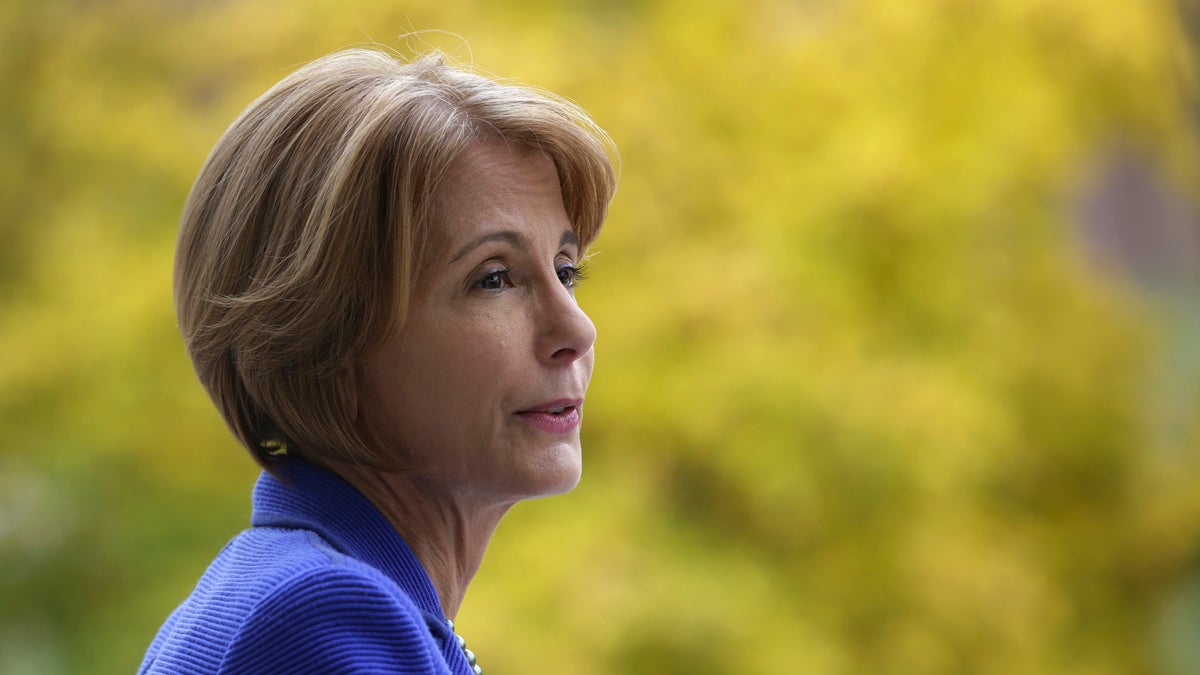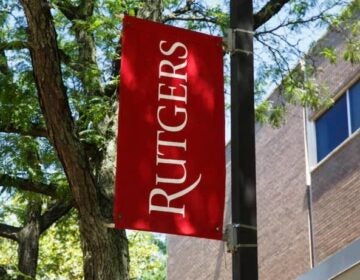Barbara Buono’s education plan is a stark contrast to Christie’s policies

Democratic New Jersey gubernatorial candidate Barbara Buono is shown speaking during a visit to Montclair State University on Thursday. (AP Photo/Julio Cortez
This is part of a series from education blogger Laura Waters of NJ Left Behind.
Democratic gubernatorial candidate Barbara Buono released her education plan for New Jersey’s public schools earlier this week and, to no one’s surprise, her vision for public education has little in common with incumbent Chris Christie’s reform-tinged agenda. While both support the Common Core State Standards, an initiative piloted by the nation’s governors to upgrade the rigor of course content, the candidates clash on just about every other item.
The two primary points of dissension between Buono and Christie involve money and accountability. How should school aid be allocated among economically diverse districts? How many services should a state system provide? And what’s the role of the State Supreme Court in adjudicating fiscal equity?
Secondly, how should N.J. should measure teacher effectiveness, a fundamental requirement of our new tenure reform law? To what extent — if any — should we use student test scores instead of traditional classroom observations?
These questions haunt N.J.’s long history of attempting to provide a fair and balanced education system to students throughout a state fragmented by pockets of affluence and poverty.
A little back story relative to the first topic of dissent. For 30 years, following rulings by the State Supreme Court, N.J. has allocated school aid based on a list of 31 impoverished “Abbott” districts, a system intended to equalize school aid regardless of resident wealth. During former Gov. Corzine’s administration, state Department of Education officials wheedled the Court into allowing the State to use a new school funding formula called the School Funding Reform Act (SFRA).
SFRA has been fully funded exactly once, in 2009, because it would cost New Jersey an extra $1 billion per year over the current $9 billion in state school aid. Christie has been clear in his disdain for the Supreme Court’s “judicial activism,” and no one doubts his desire to overturn both Abbott and SFRA.
But Buono promises that she will fully fund SFRA. In addition, she plans to expand publically-funded preschools, order full-day kindergartens for all districts, increase availability of before-school and after-school care, restore old school buildings, and offer tuition assistance at NJ’s college campuses. The total annual tab would be $3 billion per year, which she says would be covered by a Millionaire’s Tax and a 10-year phase-in.
Christie spokesman Kevin Roberts jeered, “Where is the money coming from?” Buono’s response is that the increase in allocations would be “within fiscal restraints.”
The second major item of dissension between Buono’s and Christie’s educational vision is the use of student growth data in gauging teacher effectiveness. One year ago, during negotiations for N.J.’s tenure reform law, the DOE argued that at least half of teacher and principal evaluations should be based on student test data. The final draft of the law, which Buono voted for, reduced that percentage down to 35 percent.
NJ Spotlight asked Buono to describe her thoughts on teacher evaluations:
“I did vote for [the tenure reform law], but I had grave concerns that it seemed to be the tail wagging the dog without a meaningful evaluation piece already established and tested,” she said. “Unfortunately, I think some of my fears are being realized.”
When asked what measures she would include for student performance, she did not rule out test scores entirely, but she said at a lesser degree than the 35 percent maximum that is planned for the first year by the Christie administration.
“It would have to be a small piece,” she said. “I’d have to do the research on that.”
What would replace the metric of student test data? According to Buono’s plan, “meaningful teacher evaluations through classroom observations can give new and old teachers alike the information and tools they need to enhance their teaching skills.” In other words, we can measure teacher effectiveness without the controversial and politically unpopular use of standardized assessments.
It’s true. Highly-regulated teacher observations can be a powerful metric for evaluating teacher effectiveness, but such a system (see this one in Cincinnati, for example) is very expensive and hard to implement. Those costs are not included in Buono’s projected increases in school aid.
But Buono’s plan is commendable, especially her commitment to full funding for N.J.’s neediest kids, Her reservations about N.J.’s teacher tenure reform law, which links student test scores to teacher evaluations, are shared by many educators and statisticians (not to mention NJEA, N.J.’s primary teacher union). And maybe money shouldn’t matter when devising strategies for educational opportunity.
Is there a limit to how much we should spend in sustaining and improving our current school infrastructure? Buono says “no.” Christie says “yes.”________________________________________________________
Laura Waters is president of the Lawrence Township School Board in Mercer County. She also writes about New Jersey’s public education on her blog NJ Left Behind. Follow her on Twitter @NJLeftbehind.
WHYY is your source for fact-based, in-depth journalism and information. As a nonprofit organization, we rely on financial support from readers like you. Please give today.




